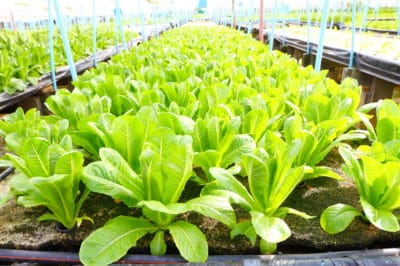How to Plant Romaine
Early spring is the best time for planting lettuce. Temperatures reaching above 75° (24° C) will cause the plant to bolt. Once a lettuce plant bolts, it becomes bitter and unpalatable. Even with light frost and shorter days, as soon as the soil can be worked you can start planting.
Preparing the Site
Rake back any mulch. Break up the soil until it is fine and not clumpy. Water the bed enough to create a moist planting medium, soil that is moist will absorb additional water more efficiently. Amend poor soils with a top dressing of compost or worm castings about ½ inch deep.
Planting the Seed
Scatter your lettuce seed across the planting bed and cover it with ¼ inch of soil or finished, screened compost. Lettuce seed is very small, and even plants that won’t grow large will still provide a small harvest so scatter generously. Keep seeds moist but not flooded.
In 7-10 days with the right conditions, your lettuce seedlings will sprout and pop out of the soil. They will be packed too closely together, but allow them to develop for 2-3 weeks before thinning. In doing this, you will be able to spot stronger seedlings and allow those ones to mature. You will also get a small microgreen harvest from the seedlings that you take out.
Thinning Seedlings
Use scissors to cut out the extra seedlings. Thin to a spacing of between 10-18 inches. Another option is to leave plants spaced at 5-6 inches with the intention of taking every other plant out later as a baby green.
Consider successional planting for a continuous harvest. There’s only so much you can do with a ton of lettuce harvested all at once. It’s far more convenient for the home gardener to harvest here and there as new heads come into maturity. To plant successionally just repeat the planting process every two weeks through spring and fall.
During high summer you may consider skipping a few weeks if the weather is consistently too warm.
How to Care for Romaine
Caring for Romaine lettuce involves a lot of observation. Since you gave it some organic fertilizer at the beginning of the season, chances are it won’t need any additional nutrients. If you notice that leaves are losing their bright green hue, consider feeding the plants again. An organic liquid compost tea or nitrogen-rich fertilizer will green them up.
Keep the plants cool and out of harsh sunlight. If you encounter hot days while growing lettuce, a shade cloth during the peak of the heat will shelter Romaine plants. Similarly, if a frost is expected, cover the crop with frost protection to avoid burn.
How to Harvest Romaine
Depending on your specific variety of Romaine, the days to maturity will be slightly different but typically Romaine matures between 55-75 days after planting. If you spaced your plants at 5-6 inch intervals, baby greens can be cut out at around 25 days.
Just go in with a sharp knife and cut every other plant off at the base at 25 days. You get a significantly higher yield by doing it this way. The plants you harvest will make great salads. Those left in the ground will grow into the new space and mature by around 60 days.
Once Romaine heads are firm and do not collapse beneath a slight squeeze, they are ready to harvest. Again using a sharp knife simply cut them off at the soil level. You can cut them higher up the stem leaving 2 inches sticking out of the ground and it will continue to produce some leaves, but it won’t head again. It’s nice to cut the heads low enough that they don’t fall apart.
Pests and Solutions
The most common pests for Romaine lettuce plants are:
- Rabbits
- Slugs and Snails
- Aphids
- Worms
- Beetles
- Nematodes
Your local pests depend on your climate, but any number of insect or animal could demolish a lettuce crop. A good fence will keep out the rabbits, but what about bugs?
The best defense is to maintain a good diversity in the garden of plants, animals, and insects. Running ducks through a planting area before seeding it will drastically reduce slug populations. Stacking rocks in sunny zones of the garden will attract snakes that primarily feed on slugs and snails.
Companion Plants
Companion plants amidst the lettuce will deter unwanted critters, and attract predatory insects. Choose aromatics like mint, dill, fennel, or lemon balm. With a good garden diversity aphids, worms, and beetles tend to clear up on their own.
